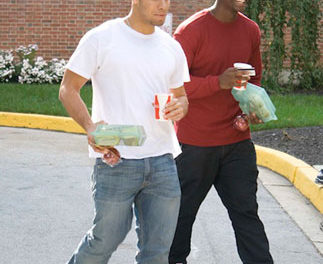by Victor Greto
For Teresa Haman, the dirt road in front of her family’s Ellendale mobile home was her link to the world.
The dusty road, just south of Milford, was how her mom got to the poultry factory job, and her dad’s first mile as a long-haul trucker.
During the early 1960s, it took her on what’s become a life-time journey of African-Americans, starting with her role as one of the first to integrate Ellendale Elementary School.
“I could have taken the road either to the poultry factory or to college,†says Haman, 54, an artist and educator.
Teresa Haman, a native Delawarean and accomplished painter, will be exhibiting her work at Wesley College’s Parker Library beginning the week of Oct. 12. The exhibit, “From Then to Now,†a series of 16 paintings and poetry, chronicles the breadth of her work.
She will speak to the Wesley community Wednesday, Oct. 20, at 4 p.m. in CC206, followed by a Q&A.
A reception at 6 p.m. will follow at the President’s House, where the public, faculty and students are invited to meet and talk with the artist.
Haman’s work is the result of her unique Delaware life.
“The most exciting thing to do in Ellendale was to stand on the corner and count the license plates,†Haman says of her youth.
She attended an all-black, two-room schoolhouse until the third grade when she was assigned to help integrate Ellendale Elementary.
“I knew I wanted to be successful,†she says. “If I didn’t, the rest couldn’t come.â€
Haman began drawing very young, then painting the sets for school plays. What kept her engaged was “Upward Bound,†a 1960s government program that encouraged poor children to pursue college.
It changed her life, taking her to Broadway shows and summer physics classes. The experience also introduced her to the University of Delaware during one six-week summer program. After graduating from high school in 1971, she decided to attend UD and major in psychology.
This idea was influenced by the fevered racial politics of the time. “I wanted to know why whites didn’t like blacks, and vice-versa,†she says.
Invigorated, she sought a career in education. After she earned her graduate degree in education at the University of Delaware, she became an outreach counselor at Delaware State College (now Delaware State University), where she helped form an Upward Bound.
It got funded, and she became the program’s director for more than three years. She went on to other schools, eventually becoming the first director of admissions at Delaware College of Art and Design in 1996. She left that position in 2004 when she decided to become financial director there.
Over the years, she nurtured her love of art by studying the widely-admired painter Edward Loper, Sr.
Haman’s work as an educator and as an artist has been recognized several times.
She has received the Christina Cultural Arts Center’s Christie Award for her “Outstanding Achievement as an Artist,†and was inducted into the Delaware Women’s Hall of Fame in 2005.
Color has become almost everything to Haman.
It’s as though the stark lines marking off the objects within her still-lifes — from “Fractured Light†and “Exciting Knowledge†to “Painters Palette†and “When It’s All Over,†her favorite — act as sinewy cages for a mottled profusion of various shades of reds, blues, yellows and greens.
Edward Loper’s influence on Haman is palpable, and as rich as her favorite colors, cerulean blue and alizarin crimson.
Haman had painted before she began studying with Loper in 1985, and did very well, but after her tutelage with him, her art radically changed.
“He taught me to look not so much at the subject but at the color I see.â€
A Loper original hangs above the fireplace mantle in the living room of the home she shares with her husband, Andrew Haman, a college beau who wooed her to his love of jazz and plied her with Tootsie Pops, a weakness.
The painting, “View from Westover Hills,†is comprised of a myriad of reds, oranges, yellows, blues and greens that reveal a road under arching trees.
“I use it for inspiration,†Haman says, who trains several cone-shaped lights upon the work.
It may only be a coincidence, but staring at the Loper work from an adjoining wall hangs her self-portrait, a figure of mottled reds accenting a resolute — almost angry — gaze.
If the self-portrait looks back toward Loper for inspiration, it also looks forward to Haman, whose face, in the intervening decades since it was painted, has softened.
Haman’s face now seems more reflective of her daughter Andrea’s portrait of her, hanging opposite the self-portrait. That painting is childlike, suffused with lighter colors.
In the chasm of difference between the two paintings rears the head of the most essential way a mature painter sees differently than the rest of us, says Loper, one of Delaware’s premier fine artists.
“You can teach yourself to see color but you have to know that it’s there,†Loper says. “Paint is color, so if you’re painting, you paint the colors you see. I’ve been teaching people how to learn to see color and how to use certain things in your work, and Teresa has been a good student at that. “
For Haman, seeing more and richer shades of color also entails looking more deeply into everything.
“To be able to create is special,†she says. “It’s breathtaking how beautiful the world is.â€








